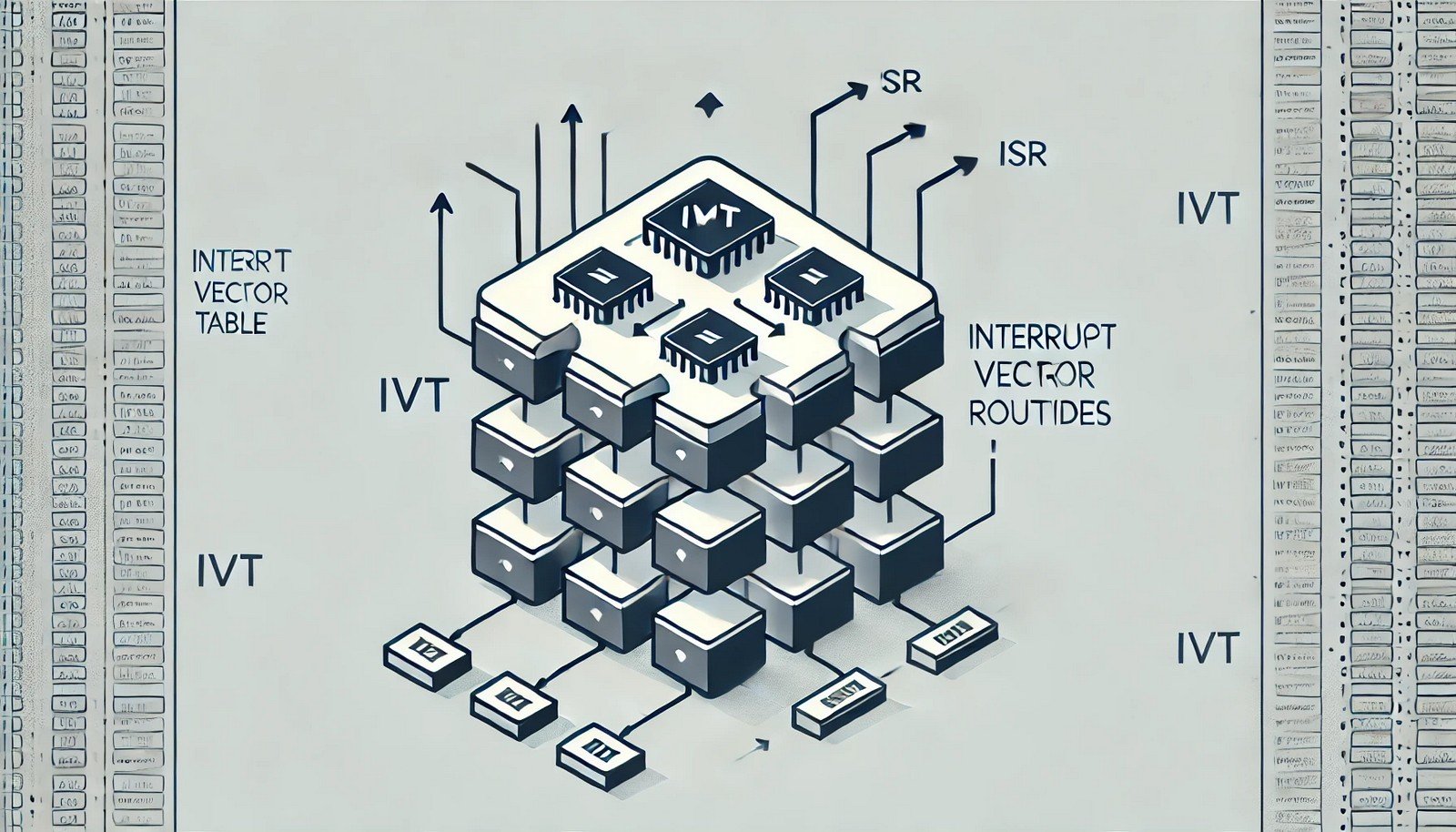Interrupt Vector Table
 (Representational Image | Source: Dall-E)
(Representational Image | Source: Dall-E)
Quick Navigation:
- Interrupt Vector Table Definition
- Interrupt Vector Table Explained Easy
- Interrupt Vector Table Origin
- Interrupt Vector Table Etymology
- Interrupt Vector Table Usage Trends
- Interrupt Vector Table Usage
- Interrupt Vector Table Examples in Context
- Interrupt Vector Table FAQ
- Interrupt Vector Table Related Words
Interrupt Vector Table Definition
An Interrupt Vector Table (IVT) is a data structure used in computer systems to handle interrupts efficiently. It is typically stored in a fixed location in memory and contains pointers (addresses) to interrupt service routines (ISRs). When an interrupt occurs, the processor uses the IVT to quickly locate and execute the corresponding ISR, reducing the time required to respond to system events. IVTs are commonly used in operating systems, microcontrollers, and embedded systems to manage hardware and software interrupts systematically.
Interrupt Vector Table Explained Easy
Imagine your house has a list of emergency contacts. If a fire breaks out, you check the list and immediately call the fire department. If there’s a medical emergency, you call an ambulance. The Interrupt Vector Table works the same way for a computer. Instead of wasting time searching, the computer instantly knows where to go when something urgent (an interrupt) happens, making everything faster and more efficient.
Interrupt Vector Table Origin
The concept of the Interrupt Vector Table emerged in early computing when processors needed an organized way to handle multiple interrupts efficiently. Early systems handled interrupts manually, but as hardware evolved, IVTs became a crucial component in real-time operating systems, microprocessors, and modern computing architectures.
Interrupt Vector Table Etymology
The term Interrupt Vector Table derives from:
- Interrupt – A signal that temporarily halts the normal execution of a program to execute a special routine.
- Vector – A pointer or address that directs the system to a specific memory location.
- Table – A structured arrangement of multiple vectors stored in memory.
Interrupt Vector Table Usage Trends
The IVT remains highly relevant in computing, particularly in embedded systems, microcontrollers, and modern CPUs. With the rise of real-time computing, the need for efficient interrupt handling has increased. Today, IVTs are crucial in areas such as industrial automation, robotics, and hardware-level virtualization. The transition from older BIOS-based interrupt handling to modern UEFI firmware has also impacted how IVTs are implemented in contemporary systems.
Interrupt Vector Table Usage
- Formal/Technical Tagging:
- Computer Architecture
- Operating Systems
- Embedded Systems
- Microcontrollers - Typical Collocations:
- "Interrupt Vector Table entry"
- "Handling interrupts via IVT"
- "Microcontroller interrupt vectoring"
- "Processor interrupt service routine"
Interrupt Vector Table Examples in Context
- The Interrupt Vector Table in x86 architecture starts at memory address
0x0000and stores interrupt service routine pointers. - Microcontrollers like the ARM Cortex-M use an IVT to manage hardware interrupts efficiently.
- The BIOS in legacy systems relied heavily on an Interrupt Vector Table to handle hardware interactions before modern operating systems took over.
Interrupt Vector Table FAQ
- What is an Interrupt Vector Table?
An Interrupt Vector Table (IVT) is a memory table that stores addresses of interrupt service routines, allowing efficient handling of system interrupts. - Why is an Interrupt Vector Table important?
It enables quick lookup and execution of interrupt handlers, improving system responsiveness and efficiency. - Where is the Interrupt Vector Table stored?
The IVT is typically stored in a reserved section of memory, often at a fixed address depending on the processor architecture. - How does an Interrupt Vector Table work?
When an interrupt occurs, the processor looks up the IVT, retrieves the corresponding address, and executes the associated interrupt handler. - What is the difference between IVT and IDT?
The Interrupt Descriptor Table (IDT) is an advanced form of IVT used in modern processors, providing more flexibility and protection features. - Do all processors use an Interrupt Vector Table?
Most modern microcontrollers and some CPUs use an IVT, but advanced architectures may use alternatives like an IDT. - Can the Interrupt Vector Table be modified?
Yes, in some systems, it can be updated dynamically to handle new interrupts, but in secure environments, it is often protected against modification. - How many entries does an IVT have?
The number of entries depends on the processor. For example, x86 IVTs traditionally had 256 entries. - What happens if an IVT entry is missing or corrupted?
The system may crash or execute unintended code, leading to instability or security vulnerabilities. - How is the IVT used in embedded systems?
Embedded systems rely on IVTs to manage hardware events efficiently, ensuring real-time performance and reliability.
Interrupt Vector Table Related Words
- Categories/Topics:
- Computer Hardware
- Operating Systems
- Real-Time Computing
- Microprocessor Design
Did you know?
The earliest Interrupt Vector Tables were introduced in the 1970s with early microprocessors like the Intel 8080. Back then, interrupt handling was a major challenge, and the IVT helped streamline the process. Today, even high-performance CPUs and microcontrollers still rely on IVTs for efficient task switching and hardware event management.
PicDictionary.com is an online dictionary in pictures. If you have questions or suggestions, please reach out to us on WhatsApp or Twitter.Authors | Arjun Vishnu | @ArjunAndVishnu

I am Vishnu. I like AI, Linux, Single Board Computers, and Cloud Computing. I create the web & video content, and I also write for popular websites.
My younger brother, Arjun handles image & video editing. Together, we run a YouTube Channel that's focused on reviewing gadgets and explaining technology.



Comments powered by CComment